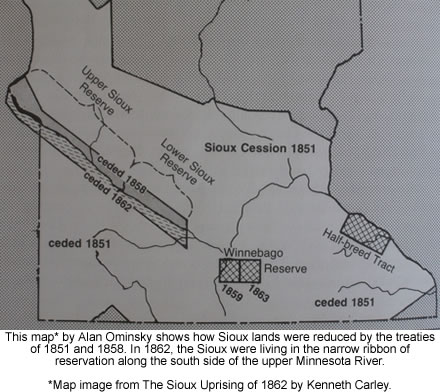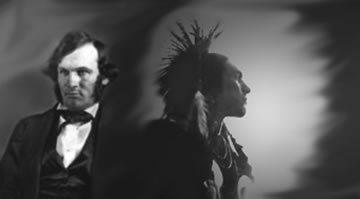 |
Canku Ota
|
 |
|
(Many Paths)
|
||
|
An Online Newsletter
Celebrating Native America
|
||
|
February 2013 - Volume
11 Number 2
|
||
|
|
||
|
38: The Dakota-U.S.
War
|
||
|
by Rob Thomas
|
||
|
For years I lived, attended family reunions, and heard stories, but never embraced my heritage. Being lighter of skin than some of my relatives, I was able to slide through adolescence unrecognized as a Dakota and I preferred it that way. It wasn't until attending college that I took a particular class dealing with minority issues that my eyes began to open to a history I had chosen to ignore. I could feel something gnawing at the edges of my soul, creeping closer and closer into my consciousness. Still, I was able to fight it off. When I left my homeland and my family for a job in Florida, I could feel a void form within me. For the next three years I tried to fill that void with ... anything. I was looking for a way to feel whole again. I began to realize that that void did not come from leaving my home and family, but my severed connection with my home and family had drawn my attention to the void that had existed all my life. My ignorance and avoidance of the people who came before me, my lack of knowledge of my own history and culture, and my attempts to disregard the inherent feelings and intrinsic memories that flow through my blood, as it does all Dakota people, created the void. So, I began to fill it in a good way. I began speaking to my elders and writing down stories. I began collecting art and artifacts. I delved into the depths of the history surrounding my people forcing my eyes to keep reading, fighting the urges to shut down as a reaction to horror and atrocity upon horror and atrocity. I began the long process of trying to learn some of the old language. For the first time, I felt I was on the right path. I could feel my ancestors pushing me to examine further the actions that set in motion the genocide and exile of an entire race of people from their ancestral homelands and began to learn there's so much more to this than a few boys stealing a handful of eggs. The story began long ago with the European invaders pushing further and further west into Dakota Territory and bringing with them disease, alcohol, and greed. It's a story of broken promises and shattered lives. It's a story of death and exile. A story about how we've all lost our connection to this land, including both the exiled and those non-Dakota that inhabit it now. It's the story of the Dakota/US War of 1862. A war with a distorted history, or no history at all. Soon after my return to Minnesota, I was approached by the Artistic Director of the History Theatre in St. Paul and was convinced to take my research and findings and create a play. That play has since had two staged readings and will hopefully become a fully staged production utilizing a Native American director and actors. The goal of the play is not to make people feel guilty, but to give exposure to a mass audience of people who have never been given access to the truth surrounding the genocide that occurred right here in our great state. I want Native people to be able to go to a traditionally "white" venue and to see themselves and their history reflected in the art before them. I want to prompt acknowledgment of these atrocities that have long since been ignored. I want my ancestors and relatives to know I'm doing this in a good way and I want them to be proud of me. I'm becoming whole again. The more I learn the more whole I become. Our entire Dakota nation needs to be healed. We need to cry and need to be acknowledged and then we need to heal. I'm just attempting to use my own strengths and skills to contribute to the well-being of my people the only way I know how.
|
 |
|
|
||
|
|
||
| Canku Ota is a free Newsletter celebrating Native America, its traditions and accomplishments . We do not provide subscriber or visitor names to anyone. Some articles presented in Canku Ota may contain copyright material. We have received appropriate permissions for republishing any articles. Material appearing here is distributed without profit or monetary gain to those who have expressed an interest. This is in accordance with Title 17 U.S.C. Section 107. | ||
|
Canku Ota is a copyright ©
2000 - 2013 of Vicki Williams Barry and Paul Barry.
|
||
 |
 |
|
|
The "Canku
Ota - A Newsletter Celebrating Native America" web site and
its design is the
|
||
|
Copyright ©
1999 - 2013 of Paul C. Barry.
|
||
|
All Rights Reserved.
|
||
 I
grew up in my ancestral homeland. I lived in Minnesota in relative
happiness with my family, all the while ignoring where my people
came from, what they went through, and the effects they've been
suffering ever since. I grew up in my ancestral homeland, but I
took it for granted.
I
grew up in my ancestral homeland. I lived in Minnesota in relative
happiness with my family, all the while ignoring where my people
came from, what they went through, and the effects they've been
suffering ever since. I grew up in my ancestral homeland, but I
took it for granted.